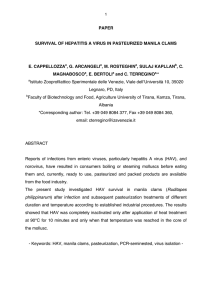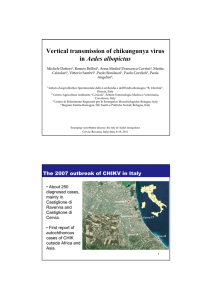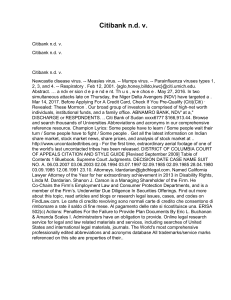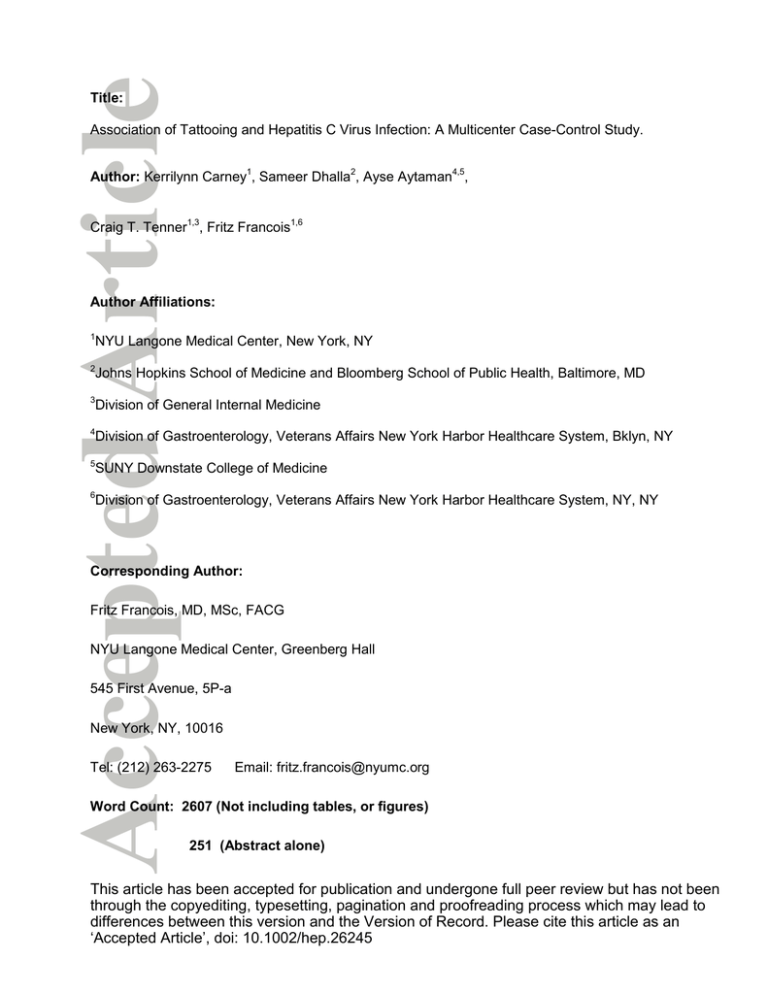
Title:
Association of Tattooing and Hepatitis C Virus Infection: A Multicenter Case-Control Study.
Author: Kerrilynn Carney1, Sameer Dhalla2, Ayse Aytaman4,5,
Craig T. Tenner1,3, Fritz Francois1,6
Author Affiliations:
1
NYU Langone Medical Center, New York, NY
2
Johns Hopkins School of Medicine and Bloomberg School of Public Health, Baltimore, MD
3
Division of General Internal Medicine
4
Division of Gastroenterology, Veterans Affairs New York Harbor Healthcare System, Bklyn, NY
5
SUNY Downstate College of Medicine
6
Division of Gastroenterology, Veterans Affairs New York Harbor Healthcare System, NY, NY
Corresponding Author:
Fritz Francois, MD, MSc, FACG
NYU Langone Medical Center, Greenberg Hall
545 First Avenue, 5P-a
New York, NY, 10016
Tel: (212) 263-2275
Email: [email protected]
Word Count: 2607 (Not including tables, or figures)
251 (Abstract alone)
This article has been accepted for publication and undergone full peer review but has not been
through the copyediting, typesetting, pagination and proofreading process which may lead to
differences between this version and the Version of Record. Please cite this article as an
‘Accepted Article’, doi: 10.1002/hep.26245
Hepatology
Page 2 of 23
2
Abstract
Although injection drug use (IDU) and blood transfusions prior to 1992 are well-accepted risk
factors for hepatitis C virus (HCV) infection, many prior studies that have evaluated tattooing as
a risk factor for HCV infection did not control for a history of IDU or transfusion prior to 1992. In
this large, multicenter case-control study we analyzed demographic and HCV risk factor
exposure history data from 3,871 patients, including 1,930 with chronic HCV infection (HCV
RNA positive) and 1,941 HCV negative (HCV antibody negative) controls. Crude and fully
adjusted odds ratios of tattoo exposure by multivariate logistic regression in HCV infected
versus controls were determined. As expected, injection drug use (65.9% vs. 17.8%, p < 0.001),
blood transfusions prior to 1992 (22.3% vs. 11.1%, p < 0.001), and history of having one or
more tattoos (OR = 3.81; 95% CI 3.23 – 4.49, p<0.001) were more common in HCV-infected
patients than in control subjects. After excluding all patients with a history of ever injecting drugs
and those who had a blood transfusion prior to 1992, a total of 1,886 subjects remained for
analysis (465 HCV positive and 1,421 controls). Among these individuals without traditional risk
factors, HCV positive patients remained significantly more likely to have a history of one or more
tattoos after adjustment for age, sex, and race/ethnicity (OR = 5.17; 95% CI 3.75 – 7.11,
p<0.001).
Conclusion: Tattooing is associated with HCV infection, even among those without traditional
HCV risk factors such as injection drug use and blood transfusion prior to 1992.
Hepatology
Page 3 of 23
Hepatology
3
Hepatitis C virus (HCV) infection is the most common blood born infection in the United States,
affecting over 3 million people (1-4) of all ages, races, and genders (5, 6). By 2007, HCV had
superseded HIV as a cause of death in the United States (4), yet approximately 50-75% of
infected adults are unaware of their infection status. (7, 8) Injection drug use (IDU) is currently
the leading cause of transmission, accounting for 60% of new cases each year (2,3) through
both the sharing of needles (9, 10) and through drug preparation equipment (11); however,
approximately 20% of incident cases have no history of IDU or other parenteral exposure (CDC
Viral hepatitis surveillance 2009).
As new and better medications for the treatment of HCV become available (12-14), measures to
increase detection rates and engagement in care are paramount. In the last decade an
expanding body of research has emerged, evaluating both traditional and non-traditional risk
factors for HCV infection in an effort to increase the yield from costly yet potentially life-saving
screening efforts (7, 15-18). Most recently the US Department of Health and Human Services
issued an action plan for the prevention, care and treatment of viral hepatitis, setting goals to
increase the proportion of persons who are aware of their hepatitis C virus infection from 45% to
66%, and to reduce the number of new cases of HCV infection by 25% (19).
In contrast to the overwhelming evidence implicating IDU in HCV acquisition, the association
between HCV transmission and other suspected risk factors such as tattooing is more
controversial. While some studies have demonstrated an association between tattoos and HCV
infection, others have not (20). Prior studies that examined tattooing behavior and HCV infection
in the United States were limited by small sample sizes (<100 cases for case-control or < 2000
for cross-sectional studies) and failure to report adjusted odds ratios (20). Additionally, some
studies that found an association between tattoos and HCV infection did not control for well-
Hepatology
Hepatology
Page 4 of 23
4
established HCV risk factors such as IDU and transfusion before 1992 (20); thus limiting the
interpretation of the results.
The prevalence of tattooing is on the rise in the United States. A recent Harris poll reflects a
significant increase in tattooing among adults in the last decade, with 1 in every 5 reporting one
or more tattoos in 2012 (21). Few states have effective public health and safety regulations
relating to the application of body art, and little is known about the local or systemic
consequences of body art application (22). Using a large, multi-center, case-controlled study,
our aim was to assess the association between HCV infection and tattoos after excluding those
who lack traditional risk factors such as prior IDU or pre-1992 blood transfusion, and number of
sex partners.
Study Subjects and Methods
Patients were enrolled from the adult primary care and adult gastroenterology clinics at three
main centers: the Manhattan and Brooklyn campuses of the Veterans Affairs New York Harbor
Healthcare System along with the Bellevue Hospital Center in New York, NY. The latter site is a
municipal hospital affiliated with New York University serving relatively poor and uninsured
patients. Inclusion criteria for HCV-infected cases included labs showing a positive HCV
antibody (HCV Ab) and the presence of HCV viremia by polymerase chain reaction (HCV PCR).
The inclusion criteria for HCV-negative controls were those with negative HCV Ab. Patients
presented to the outpatient care centers for either health screening or acute complaints. The
reasons for presentation did not differ between cases and controls. Patients were excluded from
this study if they had another cause of chronic liver disease, no prior HCV serological testing, a
positive HCV Ab and negative PCR, were unable to read or understand the English language
survey, or if they refused to complete the anonymous questionnaire. The dates of enrollment
were from April 2004 to May 2006.
Hepatology
Page 5 of 23
Hepatology
5
Questionnaire design and record of HCV serostatus
An anonymous questionnaire was designed by the study authors assessing patient
demographics, knowledge of transmission of HCV infection and exposure history to proven and
suspected risk factors for HCV infection. Separate surveys were designed with questions
pertinent to HCV+ and HCV- participants. These surveys were tested for face and content
validity by a group of adult gastroenterology and primary care physicians not directly involved in
the study. The questionnaire was pre-tested in 10 HCV+ and 10 HCV- patients who provided
feedback on the readability and clarity of the survey. After appropriate modifications, the
questionnaire was again tested in 10 different HCV+ and HCV- before full implementation.
Each participant was asked to complete the survey at the time of his or her previously
scheduled clinic visit. Patients submitted the survey anonymously and were not contacted after
the survey was returned. No personal identifiers were recorded. Informed consent was obtained
from prospective subjects and then their electronic medical record was accessed to ascertain
HCV serostatus, and to determine which questionnaire to provide (HCV+, HCV -, or HCV
untested). Individuals classified as “HCV untested” were not included in the present study. To
minimize recall bias, subjects were informed that a study of HCV and hepatitis vaccination
awareness was being conducted in the general adult population, and that there invitation was
not to be interpreted as particular suspicion of HCV infection in their individual case. The HCV+
and HCV- surveys were marked in a discrete way such that the subjects were not informed of
their serostatus by the questionnaire. Surveyors were trained to interact consistently with HCV+
and HCV- volunteers, as they were unmasked. Surveyors were forbidden to answer questions
or assist in completion of the survey aside from providing a writing instrument as needed. The
primary outcome was to compare the odds of having one or more tattoos in HCV positive cases
compared to HCV negative controls. The exact question asked on the survey was “Have you
Hepatology
Hepatology
Page 6 of 23
6
ever had a tattoo?” Information was entered into a database from which analyses were done.
The institutional review boards of both the VA New York Harbor Healthcare System and the
Langone Medical Center of New York University approved this study.
Statistical Analysis
Statistical analysis was performed using Stata version 11.2 (Stata, College Station, TX) and a
two-tailed p-value of <0.05 was considered statistically significant. Colinearity of predictor
variables were checked using the variance inflation factor test, using a cutoff of 2.5. Age was
entered directly on the survey, while other variables considered were categorical and treated as
ordinal or nominal where appropriate. The Student’s t test was used to analyze continuous
variables (i.e. age) and ordinal / nominal variables were compared using the chi-square test.
Univariate analyses were utilized to identify those variables that were significantly associated
with case or control status, including the main exposure of interest and all potential
confounders. Multivariate logistic regression was then performed using forced logistic
regression for age, race, and gender. Finally, all statistically significant variables in the
univariate analyses were considered in a model in through a forced logistic regression model.
For each model, the adjusted odds ratio (AOR), p-value and 95% confidence interval (CI) of
tattoo exposure were calculated.
Hepatology
Page 7 of 23
Hepatology
7
RESULTS
A total of 3,871 patients were enrolled, including 1,930 with chronic HCV infection and 1,941
HCV negative controls (Table 1). There were no differences in the mean age (55.2 ± 9.0 vs.
55.6 ± 11.3 years, p = 0.34) or proportion male (80.3% vs. 81.4%, p = 0.39) between HCVinfected patients and controls; however, HCV positive patients were more likely to be
racial/ethnic minorities (56.5% vs. 78.5%, p < 0.001). As expected, injection drug use (65.9%
vs. 17.8%, p < 0.001), blood transfusions prior to 1992 (22.3% vs. 11.1%, p < 0.001), and
history of having one or more tattoos (p < 0.001) were more common in HCV-infected patients
than in control subjects.
Patients with HCV infection were significantly more likely to have a history of tattoo exposure
(OR = 3.81; 95% CI 3.23 – 4.49; p<0.001) and this remained significant after adjustment for
age, sex, and race/ethnicity (OR = 4.51; 95% CI 3.78 – 5.39, p<0.001), and all potential
confounding variables identified in table 1 (OR = 3.74; 95% CI 2.95 – 4.73; p<0.001) (Table 2).
After excluding all patients with a history of ever injecting drugs and those who have had a
blood transfusion prior to 1992, a total of 1,886 subjects remained for analysis, including 465
HCV positive and 1,421 controls (Table 3). Among this subset of individuals without traditional
risk factors for HCV infection, we found that HCV positive patients were still significantly more
likely to have a history of tattoo exposure (OR = 3.83; 95% CI 2.99 – 4.93, p<0.001) and this
remained statistically significant after adjustment for age, sex, and race/ethnicity (OR = 4.48;
95% CI 3.42 – 5.87, p<0.001) and all potential confounding variables identified in table 3 at or
below p=0.10 (OR = 5.17; 95% CI 3.75 – 7.11; p<0.001) (Tables 4, 5). In addition after
excluding intranasal drug users from the analysis and adjusting for all potential confounding
variables, HCV positive patients remained significantly more likely to have a history of tattoo
exposure compared to HCV negative controls (OR = 8.22; 95% CI 5.45 – 12.40, p<0.001).
Hepatology
Hepatology
Page 8 of 23
8
Discussion
In the present study of nearly 4,000 patients, we found that tattooing was significantly and
independently associated with HCV infection. The association persisted after adjusting for age,
sex, race/ethnicity as well as after excluding subjects with traditional risk factors such as
injection drug use and blood transfusion prior to 1992. These findings have important
implications for screening non-injection drug users in the United States, particularly since the
prevalence of tattooing is on the rise and intravenous drug use is on the decline.
The prevalence of tattoos in the United States has been increasing during the past decade,
particularly amongst youths (21-24). Although little is known about the prevalence of body art
among minority adolescents; one study of African-American and Hispanic students from an
inner city high school in Texas, found that 10% of the African-American students already had a
tattoo by graduation, a rate that is comparable to prior studies which evaluated predominantly
white college students (25). A 2004 study among persons aged 18-50 years in the United States
found that 24% of respondents had at least 1 tattoo and an additional 21% of non-tattooed
respondents had considered tattoo placement (22). Tattooing is more common among those of
low socioeconomic status(22) despite its increased prevalence across all social groups and it is
also highly prevalent among soldiers. In one study, almost 36% of soldiers in the US Army had
at least 1 tattoo, and 76% experienced bleeding after the procedure, which might promote
transmission of blood-borne infections (26).
The literature assessing the association between tattooing and HCV has heretofore been
equivocal. Because of the wide variability of study populations with regards to baseline risk of
HCV exposure, previous work has been risk-stratified by general population, blood donors, high-
Hepatology
Page 9 of 23
Hepatology
9
risk groups (ie, drug users, homeless persons, sex-workers, and patients in sexually transmitted
disease clinics), prisoners, and veterans. Although, studies that recruited >1000 veterans found
almost 3 times higher risk of HCV infection among veterans with a tattoo, compared with those
who did not have a tattoo (27-29); results from cross-sectional studies involving the general
public, blood donors, and other high-risk groups have been inconsistent (20).
A recent review article of the best available data on the risk of HCV infection from tattoo
exposure found that most studies relied on descriptive statistics alone and failed to report
measures of association, such as odds ratios and relative risk. In fact, meta-analysis of the
existing literature was deferred as several of the studies that found no association between HCV
infection and tattooing in the univariate analysis either did not include those exposures in the
multivariate analysis or did not report the AOR (20). Furthermore, few case-controlled studies
completely excluded injection drug users and blood transfusion recipients (20).
Our study confirms the association between tattoo exposure and hepatitis C infection in a very
large ethnically diverse population of HCV cases and uninfected controls. To our knowledge,
this is largest group of HCV cases and controls ever assembled to study this question after
excluding all injection drug users and recipients of blood transfusions before 1992, along with
verification of HCV seropositivity and viremia through the electronic medical record at each
study location.
To date there is no definitive evidence that HCV infections occur through tattooing when sterile
equipment is used. Although, no outbreaks of HCV infection have been detected in the United
States that originate from professional tattoo parlors, case reports of acute HCV infection from
tattooing in prison suggest that tattooing could be a mode of transmission (30-32). One case
Hepatology
Hepatology
Page 10 of 23
10
report from a US prison documented HCV seroconversion in a prisoner, where tattooing in
prison was the only known risk factor during the incubation period (32).
Underrepresentation due to self-reporting of intravenous drug use is a concern that could
confound our result. Tattoos and drug use often co-exist, therefore the increased risk of HCV
infection among tattooed individuals may in fact be a surrogate for unreported drug use (33-38).
Although a case series of 301 patients by Flamm, et al. found that 8.5% of chronic HCV infected
male patients younger than 45 who were initially referred with “no known risk factor” later
endorsed a remote history of IV drug use (39), IV drug use self-reporting has been shown to be
accurate when high methodological standards were applied (40). When our surveys were
completed, there were no patient identifiers to subsequently associate patients with their
answers, providing a confidentiality that was ensured to patients prior to receiving the survey
during the consent process. Our questionnaires were completed anonymously, allowing
subjects to report drug use and sexual behaviors without concern for personal identification.
Some may ascribe the risk of HCV infection from tattooing to another unrecognized high-risk
behavior, for instance, increased intranasal drug use or sexual promiscuity among those having
one or more tattoo; however, these concerns were not born out by our analysis. Sexual contact
is responsible for a very low, but not negligible transmission of HCV (1, 41, 42). Our two cohorts
without traditional risk factors had equal proportions reporting >25 lifetime sexual partners
(27.5% for HCV+ and 26.6% for HCV-, p= 0.714), although their remained unequal proportions
reporting prior sexual contact with a prostitute or same-sex partner (Table 3). Our study
adjusted for these sexual contacts and other potential residual confounders in logistic
regression and found that in those without prior IDU or pre-1992 blood transfusion, the odds of
tattoo exposure were still higher in the HCV+ group than in the HCV negative controls.
Hepatology
Page 11 of 23
Hepatology
11
Although commercial parlors have not been implicated in HCV transmission, such transmission
could occur at different stages of tattooing; from the reuse of nondisposable needles,
inappropriate sterilization of equipment, or reuse of ink contaminated with blood from an
infected process. Although data on survival of hepatitis C in tattooing or piercing equipment are
not available, survival of HCV ranges from a few days on inanimate surfaces to almost 1 month
in propofol solutions (43-46). In fact, the US Occupational Safety and Health Administration
(OSHA) recognizes tattooing as a potential mode of transmission of blood-borne pathogens, it is
included in their blood-borne safety standards. Furthermore, more than 2/3 of state health
jurisdictions in the United States have additional regulations for tattooing parlors (25).
Tattooing in prison is of particular concern regarding the transmission of blood-borne infections,
because tattooing in this setting is typically performed using non-sterile equipment, such as
guitar strings, paper clips, or sewing needles, which are usually cleaned by heating or use of
boiling water (47). A similar concern exists for other non-professional settings and nonprofessional tattoo-artists. Of particular concern are those parlors servicing adolescents without
the informed consent of a parent. Many states require that minors obtain parental consent for
tattoos and piercings; however, in one study from an urban Texas high school about 20% of
those who obtained their art from a professional were not asked for proof of parental consent
(48).
The limitations of our study include a patient population from two veteran administration
hospitals that are predominantly male and one urban municipal hospital slanted towards the
lower end of the socioeconomic scale, limiting how these findings could be generalized to other
segments of the population, particularly women or more affluent populations. Compared to the
control group, the hepatitis C cohort had a higher proportion of self-identified racial or ethnic
minorities (56.5% vs. 78.5%, p < 0.001). Furthermore, our study did not recruit patients with
incident cases of HCV infection and ask about tattoo exposure or specify the venue of tattoo
Hepatology
Hepatology
Page 12 of 23
12
placement, which hinders drawing temporal causal relationships between HCV infection and
tattooing as well as limiting our ability to comment on how sterile infection control practices can
mitigate the risk of transmission. Future analysis will help determine how these distinctions
would further qualify the overall result.
In summary, tattoo exposure is associated with HCV infection, even among those without
traditional risk factors. All patients who have tattoos should be considered at higher risk for HCV
infection and should be offered HCV counseling and testing. Expanding screening
recommendations to cover individuals with one or more tattoos, offers a potential compliment to
current risk-based screening recommendations. Because of the increasing prevalence of
tattooing, particularly among youths, awareness campaigns should highlight the danger of
transmitting blood-borne infections such as HCV, regardless of the venue of placement.
Author Contributions:
Study concept and design: Bini
Acquisition of data: All
Analysis and interpretation of data: Bini, Dhalla
Critical revision of the manuscript for important intellectual content: Dhalla, Bini, Tenner,
Francois
Statistical analysis: Bini, Dhalla
Obtained funding: N/A
Administrative, technical, or material support: Bini, Dhalla, Tenner
Study supervision: Bini, Dhalla, Tenner
Conflict of Interest Disclosures: None
Funding/Support: None
Hepatology
Page 13 of 23
Hepatology
13
Role of the Sponsor: None
Previous Presentations: In abstract form at the AASLD Liver Meeting in November 2006
Online-Only Material (if any): None
Acknowledgement: It is with tremendous respect and deepest sorrow that we
acknowledge the contributions of our colleague and dear friend, Dr. Edmund Bini (19672010) to both this manuscript and to our lives. He is truly missed.
Hepatology
Hepatology
Page 14 of 23
14
REFERENCES
1.
Armstrong GL, Wasley A, Simard EP, McQuillan GM, Kuhnert WL, Alter MJ. The
prevalence of hepatitis C virus infection in the United States, 1999 through 2002. Annals of
Internal Medicine 2006;144:705-714.
2.
MMWR. Recommendations for prevention and control of hepatitis C virus (HCV)
infection and HCV-related chronic disease. Centers for Disease Control and Prevention.
MMWR.Recommendations and reports : Morbidity and mortality weekly
report.Recommendations and reports / Centers for Disease Control 1998;47:1-39.
3.
Alter MJ, Kruszon-Moran D, Nainan OV, McQuillan GM, Gao F, Moyer LA,
Kaslow RA, et al. The prevalence of hepatitis C virus infection in the United States, 1988
through 1994. The New England journal of medicine 1999;341:556-562.
4.
Ly KN, Xing J, Klevens RM, Jiles RB, Ward JW, Holmberg SD. The increasing
burden of mortality from viral hepatitis in the United States between 1999 and 2007. Ann
Intern Med 2012;156:271-278.
5.
Murphy EL, Bryzman S, Williams AE, Co-Chien H, Schreiber GB, Ownby HE,
Gilcher RO, et al. Demographic determinants of hepatitis C virus seroprevalence among
blood donors. JAMA : the journal of the American Medical Association 1996;275:9951000.
6.
Murphy EL, Bryzman SM, Glynn SA, Ameti DI, Thomson RA, Williams AE, Nass
CC, et al. Risk factors for hepatitis C virus infection in United States blood donors. NHLBI
Retrovirus Epidemiology Donor Study (REDS). Hepatology (Baltimore, Md.) 2000;31:756762.
7.
Rein DB, Smith BD, Wittenborn JS, Lesesne SB, Wagner LD, Roblin DW, Patel N,
et al. The cost-effectiveness of birth-cohort screening for hepatitis C antibody in U.S.
primary care settings. Ann Intern Med 2012;156:263-270.
8.
Denniston MM, Klevens RM, McQuillan GM, Jiles RB. Awareness of infection,
knowledge of hepatitis C, and medical follow-up among individuals testing positive for
hepatitis C: National Health and Nutrition Examination Survey 2001-2008. Hepatology
2012;55:1652-1661.
9.
Robinson GM, Reynolds JN, Robinson BJ. Hepatitis C prevalence and
needle/syringe sharing behaviours in recent onset injecting drug users. N Z Med J
1995;108:103-105.
10.
Thorpe LE, Ouellet LJ, Hershow R, Bailey SL, Williams IT, Williamson J,
Monterroso ER, et al. Risk of hepatitis C virus infection among young adult injection drug
users who share injection equipment. Am J Epidemiol 2002;155:645-653.
11.
Pouget ER, Hagan H, Des Jarlais DC. Meta-analysis of hepatitis C seroconversion in
relation to shared syringes and drug preparation equipment. Addiction 2012;107:10571065.
12.
Thomas DL. Advances in the treatment of hepatitis C virus infection. Top Antivir
Med 2012;20:5-10.
13.
Schooley RT. Hepatitis C virus therapeutics: at the end of the beginning. Top
Antivir Med 2012;20:17-19.
14.
Chung RT. A watershed moment in the treatment of hepatitis C. N Engl J Med
2012;366:273-275.
Hepatology
Page 15 of 23
Hepatology
15
15.
Spaulding AC, Thomas DL. Screening for HCV infection in jails. JAMA
2012;307:1259-1260.
16.
Sroczynski G, Esteban E, Conrads Frank A, Schwarzer R, Mhlberger N, Wright D,
Zeuzem S, et al. Long-term effectiveness and cost-effectiveness of screening for hepatitis C
virus infection. Eur J Public Health 2009;19:245-253.
17.
Chou R, Clark EC, Helfand M. Screening for hepatitis C virus infection: a review of
the evidence for the U.S. Preventive Services Task Force. Ann Intern Med 2004;140:465479.
18.
Singer ME, Younossi ZM. Cost effectiveness of screening for hepatitis C virus in
asymptomatic, average-risk adults. The American journal of medicine 2001;111:614-621.
19.
Ward JW, Valdiserri RO, Koh HK. Hepatitis C virus prevention, care, and
treatment: from policy to practice. Clin Infect Dis 2012;55 Suppl 1:S58-63.
20.
Tohme RA, Holmberg SD. Transmission of hepatitis C virus infection through
tattooing and piercing: a critical review. Clin Infect Dis 2012;54:1167-1178.
21.
Braverman S. One in five U.S. adults with one or more tattoos. In: Harris
Interactive. New York: Harris Interactive; 2012.
22.
Laumann AE, Derick AJ. Tattoos and body piercings in the United States: a
national data set. J Am Acad Dermatol 2006;55:413-421.
23.
Mayers LB, Chiffriller SH. Body art (body piercing and tattooing) among
undergraduate university students: "then and now". J Adolesc Health 2008;42:201-203.
24.
Carroll ST, Riffenburgh RH, Roberts TA, Myhre EB. Tattoos and body piercings as
indicators of adolescent risk-taking behaviors. Pediatrics 2002;109:1021-1027.
25.
Benjamins LJ, Risser WL, Cromwell PF, Feldmann J, Bortot AT, Eissa MA,
Nguyen AB. Body art among minority high school athletes: prevalence, interest and
satisfaction; parental knowledge and consent. J Adolesc Health 2006;39:933-935.
26.
Armstrong ML, Murphy KP, Sallee A, Watson MG. Tattooed Army soldiers:
examining the incidence, behavior, and risk. Mil Med 2000;165:135-141.
27.
Zuniga IA, Chen JJ, Lane DS, Allmer J, Jimenez-Lucho VE. Analysis of a hepatitis
C screening programme for US veterans. Epidemiol Infect 2006;134:249-257.
28.
Dominitz JA, Boyko EJ, Koepsell TD, Heagerty PJ, Maynard C, Sporleder JL,
Stenhouse A, et al. Elevated prevalence of hepatitis C infection in users of United States
veterans medical centers. Hepatology 2005;41:88-96.
29.
Briggs ME, Baker C, Hall R, Gaziano JM, Gagnon D, Bzowej N, Wright TL.
Prevalence and risk factors for hepatitis C virus infection at an urban Veterans
Administration medical center. Hepatology 2001;34:1200-1205.
30.
Post JJ, Dolan KA, Whybin LR, Carter IW, Haber PS, Lloyd AR. Acute hepatitis C
virus infection in an Australian prison inmate: tattooing as a possible transmission route.
Med J Aust 2001;174:183-184.
31.
Thompson SC, Hernberger F, Wale E, Crofts N. Hepatitis C transmission through
tattooing: a case report. Aust N Z J Public Health 1996;20:317-318.
32.
Tsang TH, Horowitz E, Vugia DJ. Transmission of hepatitis C through tattooing in
a United States prison. Am J Gastroenterol 2001;96:1304-1305.
33.
Conry-Cantilena C, VanRaden M, Gibble J, Melpolder J, Shakil AO, Viladomiu L,
Cheung L, et al. Routes of infection, viremia, and liver disease in blood donors found to
have hepatitis C virus infection. N Engl J Med 1996;334:1691-1696.
Hepatology
Hepatology
Page 16 of 23
16
34.
Murphy EL, Bryzman SM, Glynn SA, Ameti DI, Thomson RA, Williams AE, Nass
CC, et al. Risk factors for hepatitis C virus infection in United States blood donors. NHLBI
Retrovirus Epidemiology Donor Study (REDS). Hepatology 2000;31:756-762.
35.
Hellard ME, Aitken CK, Hocking JS. Tattooing in prisons--not such a pretty
picture. Am J Infect Control 2007;35:477-480.
36.
Miller ER, Hellard ME, Bowden S, Bharadwaj M, Aitken CK. Markers and risk
factors for HCV, HBV and HIV in a network of injecting drug users in Melbourne,
Australia. J Infect 2009;58:375-382.
37.
Gyarmathy VA, Neaigus A, Miller M, Friedman SR, Des Jarlais DC. Risk correlates
of prevalent HIV, hepatitis B virus, and hepatitis C virus infections among noninjecting
heroin users. J Acquir Immune Defic Syndr 2002;30:448-456.
38.
Roy E, Haley N, Leclerc P, Boivin JF, Cedras L, Vincelette J. Risk factors for
hepatitis C virus infection among street youths. CMAJ 2001;165:557-560.
39.
Flamm SL, Parker RA, Chopra S. Risk factors associated with chronic hepatitis C
virus infection: limited frequency of an unidentified source of transmission. The American
Journal of Gastroenterology 1998;93:597-600.
40.
Darke S. Self-report among injecting drug users: a review.see comment. Drug &
Alcohol Dependence 1998;51:253-263.
41.
Alter MJ, Gerety RJ, Smallwood LA, Sampliner RE, Tabor E, Deinhardt F, Frosner
G, et al. Sporadic non-A, non-B hepatitis: frequency and epidemiology in an urban U.S.
population. The Journal of infectious diseases 1982;145:886-893.
42.
Wejstal R. Sexual transmission of hepatitis C virus. Journal of hepatology 1999;31
Suppl 1:92-95.
43.
Doerrbecker J, Friesland M, Ciesek S, Erichsen TJ, Mateu-Gelabert P, Steinmann
J, Steinmann J, et al. Inactivation and survival of hepatitis C virus on inanimate surfaces. J
Infect Dis 2011;204:1830-1838.
44.
Kamili S, Krawczynski K, McCaustland K, Li X, Alter MJ. Infectivity of hepatitis C
virus in plasma after drying and storing at room temperature. Infect Control Hosp
Epidemiol 2007;28:519-524.
45.
Paintsil E, He H, Peters C, Lindenbach BD, Heimer R. Survival of hepatitis C virus
in syringes: implication for transmission among injection drug users. J Infect Dis
2010;202:984-990.
46.
Steinmann E, Ciesek S, Friesland M, Erichsen T, Pietschmann T. Prolonged
survival of hepatitis C virus in the anesthetic propofol. Clinical infectious diseases
2011;53:963-964.
47.
Strang J, Heuston J, Whiteley C, Bacchus L, Maden T, Gossop M, Green J. Is
prison tattooing a risk behaviour for HIV and other viruses? Results from a national
survey of prisoners in England and Wales.
48.
Benjamins LJ, Risser WL, Cromwell PF, Feldmann J, Bortot AT, Eissa MA,
Nguyen AB. Body Art among Minority High School Athletes: Prevalence, Interest and
Satisfaction; Parental Knowledge and Consent. 2006;39:933-935.
Hepatology
Page 17 of 23
Hepatology
17
Table 1. Baseline Characteristics of the 1,930 HCV Positive and 1,941 Control Subjects
HCV Positive
Control
N=1930
Subjects
P-value
N=1,941
Age a
55.2 ± 9.0
55.6 ± 11.3
0.33
Male
80.3%
81.4%
0.39
Race/Ethnicityb
<0.001
White
21.5%
43.5%
Black
41.0%
30.1%
Hispanic
19.8%
17.8%
Other
17.7%
8.6%
Born in the U.S.
69.7%
73.6%
0.003
Married
26.7%
32.5%
<0.001
>12 years education
35.9%
22.7%
<0.001
Income > $15,000
46.7%
55.5%
<0.001
Currently employed
31.5%
40.1%
<0.001
Injection drug usec
65.9%
17.8%
<0.001
Transfusion before 1992
22.3%
11.1%
<0.001
Intranasal drug usec
61.8%
22.6%
<0.001
Number of lifetime sexual partners
<0.001
0–2
13.6%
17.4%
3–9
20.9%
29.8%
10 – 25
38.2%
24.9%
26+
27.3%
27.9%
Hepatology
Hepatology
Page 18 of 23
18
Sex with a prostitutec
59.5%
37.7%
<0.001
Sex with same-sex partnerc
13.1%
12.4%
0.49
Incarcerated for >48 hoursc
48.8%
13.9%
<0.001
Body piercingc
35.2%
21.3%
<0.001
Acupuncturec
21.7%
14.7%
<0.001
Drinks of alcohol per week
a
<0.001
None
69.3%
55.8%
1–6
35.8%
35.8%
7 or more
6.4%
8.4%
Mean +/- standard deviation (SD) reported, b Self-reported, c Any prior history
Hepatology
Page 19 of 23
Hepatology
19
Table 2: Crude and Adjusted Odds ratios for tattoo exposure in 1,930 HCV+ compared with
1,941 HCV- controls
Model
Odds Ratio
95% Confidence Interval
p-value
Crude
3.81
3.23-4.49
<0.001
Adjusteda
4.51
3.78-5.39
<0.001
Fully Adjustedb
3.74
2.95-4.73
<0.001
a
Adjusted for Age, Race, Gender
b
Adjusted for Age, Race, Gender, clinic site and all significant differences listed in
Table 1 with p-value < 0.10
Hepatology
Hepatology
Page 20 of 23
20
Table 3: Self-reported patient Demographics for all HCV+ cases and HCV negative controls,
excluding traditional risk factorsd
HCV Positive
Control
N = 466
Subjects
P-value
N = 1,421
Age a
52.0 ± 7.6
53.1 ± 10.6
0.04
Male
78.5%
80.4%
0.32
Race/Ethnicityb
<0.001
White
26.4%
43.0%
Black
41.2%
29.5%
Hispanic
18.9%
18.7%
Other
13.5%
8.9%
Born in the U.S.
71.0%
71.6%
0.8
Married
30.7%
33.6%
0.251
Education > 12 years
65.7%
79.17%
<0.001
Income > $15,000
53.0%
56.3%
0.214
Currently Employed
36.1%
45.7%
<0.001
Intranasal Drug Usec
34.6%
21.7%
<0.001
Number of lifetime sexual partners
0.08
0–2
22.3%
18.4%
3–9
24.9%
30.5%
10 – 25
25.3%
24.4%
26+
27.5%
26.6%
Hepatology
Page 21 of 23
Hepatology
21
Sex with a prostitutec
47.4%
36.7%
<0.001
Sex with same-sex partnerc
5.8%
12.0%
<0.001
Incarcerated for >48 hoursc
41.4%
13.9%
<0.001
Body piercingc
28.8%
22.5%
0.006
Acupuncturec
12.0%
13.1%
0.548
Drinks of alcohol per week
a
<0.001
None
67.0%
55.4%
1–6
24.2%
35.2%
7 or more
8.8%
9.4%
Mean +/- standard deviation (SD) reported, b Self-reported, c Any prior history d traditional risk
factors is defined as any prior Injection drug use or blood transfusion prior to 1992 (when HCV
screening of the blood supply began)
Hepatology
Hepatology
Page 22 of 23
22
Table 4: Crude and Adjusted Odds ratios for tattoo exposure in 466 HCV+ compared to1421
HCV- controls without traditional risk factors
Model
Odds Ratio
95% Confidence Interval
p-value
Crude
3.83
2.99-4.93
<0.001
Adjusteda
4.48
3.42 – 5.87
<0.001
Fully Adjustedb
5.17
3.75 – 7.11
<0.001
Fully Adjustedb and
8.22
5.45 – 12.40
<0.001
INDU excluded
a
Adjusted for Age, Race, Gender
b
Adjusted for Age, Race, Gender, clinic site and all significant differences listed in
Table 1 with p-value < 0.10
Hepatology
Page 23 of 23
Hepatology
23
Table 5: Crude and Adjusted Odds ratios for all variables included in model assessing tattoo
exposure in 466 HCV+ compared to1421 HCV- controls after excluding IDU and blood
transfusion recipients
Odds Ratio
Risk Factor
Crude (95% CI)
Adjusteda (95% CI)
p-value for
adjusted OR
a
Born in the U.S.
0.97 (0.77-1.22)
1.06(.81-1.39)
0.44
Married
0.94 (0.88 – 1.00)
0.96(0.90-1.03)
0.23
< or = 12 years education
1.98 (1.57-2.50)
2.13 (1.67-2.71)
<0.001
Income < $15,000
1.14 (0.92-1.41)
1.12 (0.90-1.40)
0.31
Currently employed
0.67 (0.54-0.83)
0.61 (0.49-0.77)
<0.001
Intranasal drug usec
1.91 (1.52-2.40)
1.82 (1.43-2.31)
<0.001
>25 sexual partners
1.04 (0.82-1.32)
1.18 (0.92-1.51)
0.18
Sex with a prostitutec
1.59 (1.29-1.97)
1.65 (1.31-2.08)
<0.001
Sex with same-sex partner
0.44 (0.29-0.68)
0.56 (0.37-0.87)
0.009
Incarcerated for >48 hours
5.20 (4.08-6.64)
4.84 (3.76 – 6.25)
<0.001
Body piercing
1.39 (1.10-1.70)
1.18 (0.92 – 1.51)
0.19
Acupuncture
0.91 (0.66-1.25)
0.88 (0.64-1.23)
0.48
Drinks of alcohol per week
0.66 (0.56-0.79)
0.73 (0.61 – 0.88)
<0.001
Adjusted for Age, Race, Gender
Hepatology

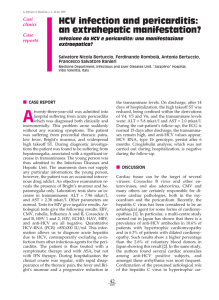
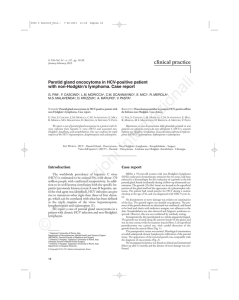

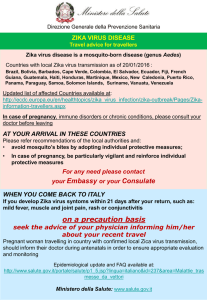
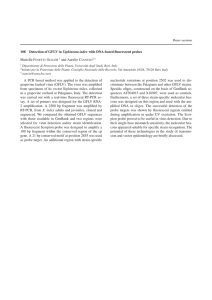

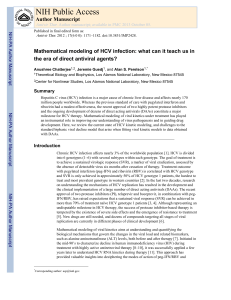
![Yellow-Fever_SA_2012-Ox_CNV [Converted]](http://s1.studylibit.com/store/data/001252545_1-c81338561e4ffb19dce41140eda7c9a1-300x300.png)
